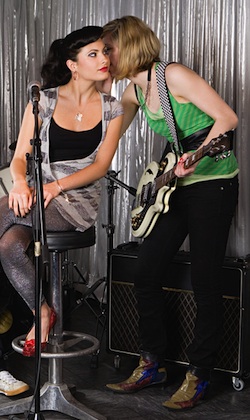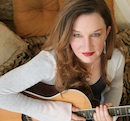Being able to play by ear is one of the most desirable skills among musicians. But many people assume it’s a gift: you’ve either got it or you don’t. In this series so far I hope we’ve convinced you otherwise. You can learn to play by ear!
Still not sure? Today we welcome Lisa McCormick to the site to explain just how easy it can be, as she reveals the “sexy secret” of “one, four, five”…
 Let’s face it, sometimes music theory just doesn’t seem very sexy.
Let’s face it, sometimes music theory just doesn’t seem very sexy.
But wait –
Have you ever lusted after figuring out how to play a song on the guitar or piano, instantly, just by ear?
No sheet music, no tabs, no chord charts. Just you, the naked song, and the starry night. A match made in heaven.
Turns out, you may be a whole lot closer to that than you think.
In many cases, all you need is an understanding of the magic of “One, Four, Five”, in order to quickly figure out how to play thousands of songs, by ear.
What’s “One, Four, Five”?
“One, Four, Five” is common shorthand for Basic Chord Theory. And Basic Chord Theory is the hidden system behind what makes chords work together, within a key.
If you play a chord-based instrument (guitar, piano, organ, banjo, mandolin, ukulele, etc.), understanding Basic Chord Theory can be a real game changer for you and how you connect with your instrument.
What Does it Mean?
Let’s roll up our sleeves and dig in. Ready?
Every major key (like the key of C, for example), has a corresponding major scale (the C major scale).
(alternatively: sing the first line to the Christmas Carol “Joy to the World”… and you’ll have the major scale – backwards!)
Now, replace the Do, Re, Mi’s, etc. with numbers:
We’re going to be interested in #1, #4 and #5… But what are they? Sticking with the example of the key of C, and the C major scale, sing or play the scale starting on C:
With me so far?
Single out number 1, number 4, and number 5 (“One, Four, Five”, remember?)
Finally, play those as major CHORDS (not just notes). You get a C major chord, an F major chord, and a G major chord.
Ready for the Sexy Part?
Now let’s use these three chords (the “One”, the “Four”, and the “Five”) to figure out how to play a song by ear. Grab your instrument and play along as you read.
Let’s use the song “Happy Birthday” as our guinea pig (and hope that Warner Chappell don’t sue us.)
Play a C chord on your instrument, and sing “Happy” (with your voice on the note G). Keep going into the song (“…birthday to…”), playing a C chord the whole time.
When you get to the word “You”, you’ll notice the C chord clashes with your voice!
Ouch. Time to try a different option.
The rule of thumb here is to keep playing the same chord until you reach a point in the song where that chord does not work any more.
Here’s the trick: rather than trying every other chord in the world to fix the problem, try using either the “Four” chord (F major), or, the “Five” chord (G major), to accompany the word “You” in the song.
Turns out the G chord sounds pretty good there – that’s the “Five chord”, remember.
Keep playing the G chord, and singing the song (“…you…Happy birthday to…”). When you get to the word “you”, you should hear that it sounds like it’s time to change chords.
Again, don’t waste your time trying every chord in the world. Try your other two options from our “one”, “four” and “five”: the C (“one”) or the F (“four”) chord.
… and you’ll find the C chord sounds pretty good there (the “One” chord).
Stay with the C chord, and keep singing the song (“…you…Happy birthday dear…”), and now, when you get to the word “Lisa” (sorry, couldn’t resist!), it’s time to change chords again.
What are your options? F, or G. Let’s try the F, just for ha ha’s (the “Four” chord).
Sing my name (or maybe the name of your true love…) and play the F chord. Ah, sweet perfection!
Keep with the F chord, and keep singing the song. (“…Lisa…Happy…”).
When we get to “Birthday”, the F no longer sounds good, and the chord wants to change again.
What’ll you go for? The C? The G?
… if you figured out that it is a C, you get an extra present on your next birthday!
Almost to the end of the song now. Sing “To”, and play G. Sing “You” and play C.
Now congratulate yourself and make a wish! You’ve figured out the chords to this song by ear.
Five More Little Factoids You Need to Know:
- This system works in every key, exactly the same way. Try working out the same song, in another key. How about the key of G?
- This system will work for thousands of basic songs. Folk songs, pop songs, rock songs (remember “Three chords and an attitude”? THIS is what they were talking about!).
- The more you practice working songs out by this system of trial and error, the better and faster you’ll get at it. Playing by ear will begin to come to naturally.
- When “1”, “4” and “5” don’t cut it, try the “2”, “3”, or the “6”. But here’s the rub: play these as MINOR chords!
- Amongst musicians, chord-numbers are represented with Roman Numerals. Now that you understand the basics of the system, start using the nomenclature that the big kids use: 1 = I, 2 = II, 3 = III, 4 = IV, 5 = V, 6 = VI, 7 = VII.
You may be wondering “What about the VII chord?” In fact it shows up far less frequently than 1 through 6. And when it does, it is played as a diminished chord. Let’s worry about that one later!
Now, Go Forth and Play!
Now that you know the secret system behind I-IV-V (that’s “One, Four, Five, remember), try it on some other common basic songs, just to get the hang of it.
Try ‘Yankee Doodle’. ‘Rockabye Baby’. ‘You Are My Sunshine’. ‘Amazing Grace’. ‘Joy to the World’. ‘Blue Suede Shoes’…
Amaze yourself and impress your listener as song after song after song pours out of you and your instrument, seemingly like magic.
Now, that’s sexy.
Thanks Lisa for that great tutorial. Now you can see how to figure out songs by ear yourself – and as we discussed before, that’s step one in learning to play by ear!









Great post! Love the Joy to the World and Happy Birthday references. I'm stealing those :) Cheers from DLP_DSM, continued success, and keep up the great work!
Lisa I like the easy way that you teach. It makes it easy to do only if I could remember the words besides the melody. I'll have to use a book for the words. Thanks for the way you teach.
I have guitar ease from 3/12.This is so cool. Makes a beginner feel powerful. I purchased song books looking for favorite songs to strum. Guitar ease is easy, quick, and will get you playing today. I love guitar ease. and guitar tricks. Thank you lisa.
Very good for beginners.
I really enjoy your easy repartee, esp. lessons with GuitarTricks and now these
posts on GSWG.
L.L.L.